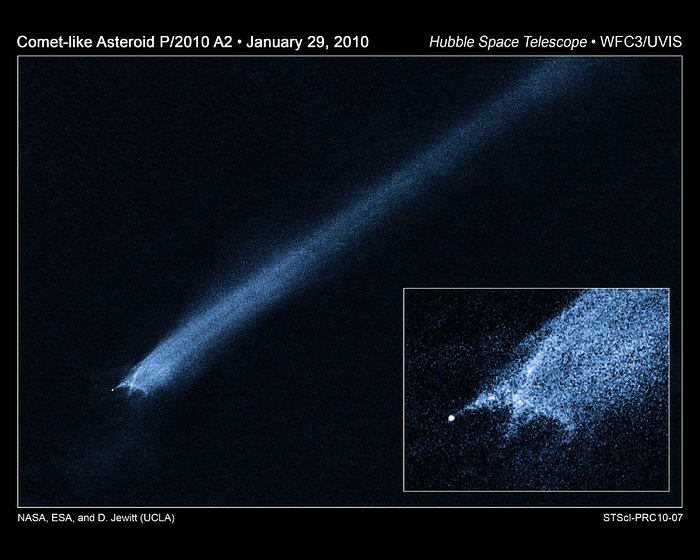Hubble views of comet-like asteroid P/2010 A2
This is a NASA/ESA Hubble Space Telescope picture a comet-like object called P/2010 A2, which was first discovered by the LINEAR (Lincoln Near-Earth Asteroid Research program) sky survey on 6 January. The object appears so unusual in ground-based telescopic images that discretionary time on Hubble was used to take a close-up look. This picture, from the 29 January observation, shows a bizarre X-pattern of filamentary structures near the point-like nucleus of the object and trailing streamers of dust.
The inset picture shows a complex structure that suggests the object is not a comet but instead the product of a head-on collision between two asteroids traveling five times faster than a rifle bullet (5 kilometres per second). Astronomers have long thought that the asteroid belt is being ground down through collisions, but such a smashup has never before been seen.
The filaments are made of dust and gravel, presumably recently thrown out of the 140-metre-diameter nucleus. Some of the filaments are swept back by radiation pressure from sunlight to create straight dust streaks. Embedded in the filaments are co-moving blobs of dust that likely originate from tiny unseen parent bodies. An impact origin would also be consistent with the absence of gas in spectra recorded using ground-based telescopes.
At the time of the Hubble observations, the object was approximately 300 million km from the Sun and 140 million km from Earth. The Hubble images were recorded with the new Wide Field Camera 3 (WFC3). The image was taken in visible light. The colour in the image is not what the human eye would see. A blue colour map was added to bring out subtle details.
Credit:NASA, ESA and D. Jewitt (UCLA)
About the Image
About the Object
| Name: | P/2010 A2 (LINEAR) |
| Type: | Solar System : Interplanetary Body : Asteroid |
| Category: | Solar System |
Colours & filters
| Band | Wavelength | Telescope |
|---|---|---|
| Optical V | 606 nm |
Hubble Space Telescope
WFC3 |
